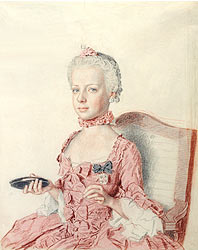
As the art world grows swollen—bloated by money, distended by exaggerations of scale—the small becomes more interesting to those with a contrary turn of mind. Jean-Étienne Liotard (1702–1789), an unfamiliar artist here but well-known in his native Switzerland, was a sharp-eyed master of the tiny but brilliant effect. At home as a miniaturist, he preferred pastels to oils and was better at portraying intelligent women than important men. His women become intimates who, it seems certain, could amuse a salon or charm a stranger in a corner tête-à-tête. Flaubert, no small student of women, described one Liotard subject this way: “Mme de l’Épinay [sic], thin face, black hair, black eye, long jaw, homely, but a woman one notices and that one would surely love greatly if one loved (she must have smelled either rank or sweet).”
She must have smelled either rank or sweet. What an extraordinary thing to say about a woman whom you’ve just met in an eighteenth-century picture! Obviously Liotard, unlike most miniaturists, did not just concoct perfumed pieces of flattery. As Flaubert suggests, his women are complete beings, with a visceral quality as well as an intellectual one; they have about them the fume of the body. The petite but tasty exhibit of Liotard’s work now at the Frick Collection, organized by Colin B. Bailey and Kristel Smentek, contains several richly worked pastels of such women. It also includes a remarkable series of drawings, some highlighted with watercolor, of eleven of the sixteen children of Empress Maria Theresa of Austria. All wear the artificial dress of the era, yet in each case, the child peeks through the presentation. If the family resemblance is startling, so are the subtle distinctions of character. The catalogue notes that the 7-year-old Marie Antoinette—who would lose her head in the French Revolution—has a gaze of both “striking intensity” and “a certain hardness.” The ribbon around her neck will arouse particular interest.
Liotard worked hard at his trompe l’oeil effects: His detailing can be unbelievably itty-bitty. (The Frick provides magnifying glasses.) In certain drawings, he rubbed color onto the back of his semi-transparent paper in order to subtly enrich the luster of the figure. Such realism, when done on a small scale, creates the delightful illusion that you can keep the world in a drawer or your daughter clasped in a locket. At the same time, Liotard, while not an in-your-face realist, insisted that even this reassuring realism must sometimes acknowledge physical flaws.
He took special pleasure in depicting his own peculiarities. If there was any subject he preferred to women, it was probably himself. The exhibit contains several self-portraits, including one, Liotard Laughing, in which the grinning artist is gap-toothed. He looks like a gleeful old goat. As a young man, Liotard had gone East and, after returning to Europe, affected Turkish dress and a beard. No doubt he made entrepreneurial use of his eccentricities. Then as now, a singular appearance or attitude could help get an artist noticed: It became fashionable to have one’s portrait done by Liotard.
There are some shadows. He lived to a great old age. One self-portrait, in which he renders himself holding his chin, has the meditative air of a late Rembrandt; the flesh sags with thought and experience. And his later still lifes have the quiet charm of an artist who, his purview having narrowed, stays home. In one trompe l’oeil, Liotard depicts depictions—two bas-relief mythological scenes and two portraits casually stuck onto wood. Art-about-art realism, in other words. Liotard may come from another world, but the philosophical conundrums of that picture would fit nicely into MoMA’s current show of Dada.
Jean-Étienne Liotard (1702–1789): Swiss Master
Frick Collection. Through September 17.